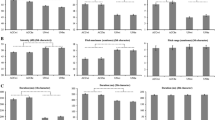Abstract
Three experiments involving ongoing sentence perception are described. A nonword detection (NWD) latency procedure was employed without a concurrent task (Experiment I), with a concurrent comprehension task (Experiment II), and with a concurrent recall task (Experiment III). Predictions were made based on two plausible models of sentence perception—predictive analysis (PA) and segmentational analysis (SA). Both characterize the hearer as actively imposing a grammatical structure on the input. PA constructs a surface structure representation sequentially (i.e., on a word-by-word basis). SA partitions off clauselike units before establishing the structure of smaller within-clause constitutents. The NWD latency data generally support a PA system (particularly when a concurrent task is used). The results of a nongrammatical condition in Experiment III confirmed that the general findings were not artifactual.
Similar content being viewed by others
References
Aaronson, D. (1968). Temporal course of perception in an immediate recall task.J. Exp. Psychol.,76:129–140.
Aaronson, D. (1976). Performance theories for sentence coding: Some qualitative observations.J. Exp. Psychol: Hum. Percept. Perform. 2:42–55.
Abrams, K. (1972). A further investigation into reaction time to pulses in speech. Paper delivered to the 84th meeting of the Acoustical Society of America in Miami Beach, Fl.
Abrams, K., and Bever, T. G. (1969). Syntactical structure modifies attention during speech perception and recognition.Q. J. Exp. Psychol. 21:280–290.
Chapin, P. G., Smith, T. S., and Abrahamson, A. A. (1972). Two factors in perceptual segmentation of speech.J. Verb. Learn. Verb. Behav. 11:164–173.
Cole, R. A. (1973). Listening for mispronunciations: A measure of what we hear during speech.Percept. Psychophys. 13:153–156.
Conrad, C. (1974). Context effects in sentence comprehension: A study of the subjective lexicon.Memory Cogn. 2:130–138.
Fillenbaum, S. (1970). On the use of memorial techniques to assess syntactic structure.Psychol. Bull. 73:231–237.
Flores d'Arcais, G. B. (1974). Is there a memory for sentences?Acta Psychol. 38:33–58.
Fodor, J. A., and Garrett, M. F. (1971). A donsolidation effect in sentence perception: Research Laboratory of Electronics, M.I.T..Q. Progr. Rep. 100:182–185.
Fodor, J. A., Bever, T. G., and Garrett, M. F. (1974).The Psychology of Language: An Introduction to Psycholinguistics and Generative Grammar, McGraw-Hill, New York.
Foss, D. J., and Jenkins, C. M. (1973). Some effects of context on the comprehension of ambiguous sentences.J. Verb. Learn. Verb. Behav. 12:577–589.
Foss, D. J., and Lynch, R. E. (1969). Decision processes during sentence comprehension: Effects of surface structure on decision times.Percept. Psychophys. 4:145–148.
Hakes, D. T., and Foss, D. J. (1970). Decision processes during sentence comprehension: Effects of surface structure reconsidered.Percept. Psychophys. 8:413–416.
Hockett, C. F. (1961). A grammar for the hearer. In Jakobson, R. (ed.),Proceedings of Symposia in Applied Mathematics Vol. 12, American Mathematical Society, Providence, R.I.
Holmes, V. M., and Forster, K. I. (1970). Detection of extraneous signals during sentence recognition.Percept. Psychophys. 7:297–301.
Keyser, S. J., and Halle, M. (1968). What we do when we speak. In Kolers, P., and Eden, M. (eds.),Recognizing Patterns, MIT Press, Cambridge, Mass.
Kimball, J. (1973). Seven principles of surface structure parsing in natural language.Cognition 2:15–47.
Kimball, J. (1975). Predictive analysis and over-the-top parsing. In Kimball, J. (ed.),Syntax and Semantics, Vol. IV, Academic Press, New York.
Lingoes, J. C. (1973).The Guttman-Lingoes Nonmetric Program Series, Mathesis Press, Ann Arbor, Mich.
Reber, A. S. (1973). Locating clicks in sentences: Left, centre, and right.Percept. Psychophys. 13:133–138.
Reber, A. S., and Anderson, J. R. (1970). The perception of clicks in linguistic and nonlinguistic messages.Percept. Psychophys. 8:81–89.
Sachs, J. D. (1967). Recognition memory for syntactic and semantic aspects of connected discourse.Percept. Psychophys. 2:437–442.
Seitz, M. R., and Weber, E. A. (1974). Effects of response requirements on the location of clicks superimposed on sentences.Memory Cogn. 2:43–46.
Author information
Authors and Affiliations
Rights and permissions
About this article
Cite this article
Whaley, C.P. Predictive analysis vs. segmentational analysis in sentence perception. J Psycholinguist Res 8, 523–542 (1979). https://doi.org/10.1007/BF01071181
Received:
Issue Date:
DOI: https://doi.org/10.1007/BF01071181




